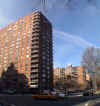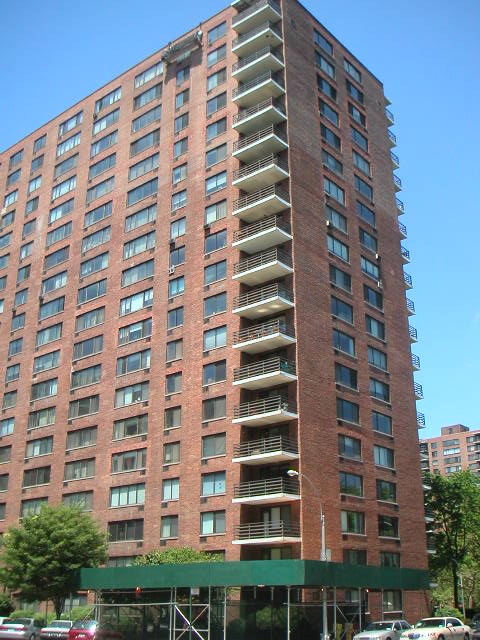|
One of the city's largest and most
controversial "urban renewal" projects, Park West Village was initially
known as Manhattantown and then West Park Apartments.
In his book, "Public Works: A Dangerous
Trade," (McGraw-Hill Book Company, 1970), the imperious master builder
Robert Moses, who had been the City Construction Coordinator and the
chairman of the city's Committee on Slum Clearance when the project was
initiated, recalled that:
"The project was conceived in the spring of 1949 when seven local civic
organizations joined to form the West Side Housing Committee. Later that
year, the committee reported on their findings and requested action on a
slum clearance and public housing project for the Bloomingdale section
west of Central Park. In June of 1950, Congressman Franklin D. Roosevelt
Jr., whose 20th Congressional District embraced this area, started to
translate the report into concrete action. Because of the high assessed
valuation of the land, an initial request to the New York City Housing
Authority was not granted, but a subsequent request prepared in
accordance with Title I and directed to the Slum Clearance Committee was
viewed favorably."
"Manhattantown was the first massive
renewal project to be scrutinized on a cost-benefit basis that took into
serious consideration the plight of those living on the site," noted
Robert A. M. Stern, Thomas Mellins and David Fishman in their book, "New
York 1960," (The Monacelli Press, 1995).
"Opponents of the project," they continued, "argued that the city's
current residents would not benefit from the renewal process because
the...new dwelling units proposed for the seventeen twenty-story
buildings [in the original plan] would not only be too expensive but
would also represent a significant reduction in the amount of housing
presently available on the site. It was not statistical analysis,
however, but charges of rampant corruption running throughout the entire
Title 1 slum clearance program in New York that compromised
Manhattantown. After charges of corruption led to an investigation in
the Senate Committee on Banking and Currency in the fall of 1954, Mayor
Wagner banned future work for five years on Title 1 projects of all
initial private participants in Manhattantown, including the architect
Melvin E. Kessler of S. J. Kessler & Sons, who had taken an equity
position in the development and whose fees had been misrepresented in
the sponsors' public filings. Moses's deals with developers had come to
reek of cronyism, and he had let Manhattantown drag on for years as the
first developers milked the project by collecting rents from on-site
tenants living in condemned housing, which the temporary landlords were
not obliged to maintain to any decent standard. As a result of the Title
1 scandals, and those surrounding the Manhattantown project in
particular, Moses and his high-handed approach began to be carefully
examined in the press..."
In his exhaustive, fascinating and vitriolic book, "The Power Broker,
Robert Moses And The Fall Of New York, (Alfred A. Knopf, 1974), author
Robert Caro documents in great detail the history of this project:
"The Manhattantown area was a slum area. Its people were poor; the average
weekly income was sixty dollars per family. Its buildings were old;
there hadn't been a new building constructed in it in twenty-five years.
Most of them were overcrowded with families of five or six members
jammed into apartments that should have held no more than three or four,
and many were dilapidated. But the area also was stable, settled,
friendly....The Mayor's Slum Clearance Committee had handed over to
Caspert and Company six square blocks of Manhattan real estate, worth
$15,000,000, for $1,000,000....[in 1956,] Manhattantown, Inc., whose tax
arrears had now topped $600,000 and were rising every day, had, because
its officers had been siphoning out the money as fast as it came in,
none available to pay the taxes any time in the foreseeable
future,...there was also no money in sight to pay the interest on the
$2,000,000 mortgage Moses had persuaded the city to give them, let alone
the amortization,...that there was no money in sight to build any of the
buildings the corporation had, more than five years before, contracted
to build....Moses had no choice. On June 11, the Slum Clearance
Committee asked the Board of Estimate to institute foreclosure
proceedings and take back the property in the name of the city so that
it could be turned over to a new sponsor....Under the arrangement, Webb
& Knapp would not merely insure Manhattantown's principals against any
liability to the city. It would buy out the two principal stockholders -
Seymour Milstein and Jack Ferman (Caspert having prudently sold out
before the company's collapse) - for $533,250, and put them on Webb &
Knapp's payroll as `consultants' for five years at a fee of $30,000 a
year, a total of $150,000 more. These two men, key figures in
Manhattantown since its inception, were not merely being allowed, after
five years of delay - five years during which they had made fortunes -
to slip quietly into the night without punishment. They were also being
paid hundreds of thousands of dollars to do so. And this money was not
for all their stock. Under the Moses-approved arrangements, Ferman and
Milstein would be given sizable stockholdings - between them a total of
32 percent - in Webb & Knapp's Manhattantown subsidiary....Outcry in the
press - the afternoon press, primarily - apparently panicked the
administration" and portions of the arrangement were subsequently
revised. (Seymour Milstein would go on eventually with his brother,
Paul, to become one of the city's major developers and landlords.)
The Manhattantown "revelations," Caro continued, "hardly touched Robert
Moses at all. The fear and awe in which he was held by reporters,
rewritemen, copy editors and city editors was never more evident than on
the day following the Senate hearing on Manhattantown and in the days
that followed. Robert Moses had conceived the Manhattan project. He had
directed its planning. He had selected the cast of characters who ran
it. He had shifted the cast around when the political winds in the city
shifted. It was a Robert Moses project from beginning to end. The [New
York] Times story on Manhattantown did not mention Robert Moses
once...."
|

